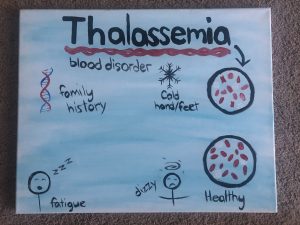Thalassemia is a hereditary blood disorder, where the body does not produce enough hemoglobin. These blood cells cannot always function properly, and the body has difficulty oxygenating the tissues. There are different types of thalassemia, and severity varies. Some people show no symptoms, while others develop anemia, and need regular blood transfusions. Symptoms include fatigue, dizziness, cold hands/feet, slow growth, and weakness. I painted this picture showing healthy blood cells and thalassemia blood cells, and also some symptoms.


Elizabeth did her project on Thalassemia, a blood disorder that seems to be genetic. This project overall covers the objective “describe disorders of the blood and how they can be treatedâ€. Elizabeth painted illustrations of symptoms including a person looking dizzy, a person who appears to be sleepy, a snowflake to display cold hands and feet, as well as a little piece of DNA to display family history. She also paints a view of Thalassemic blood next to a view of healthy blood as if looking through a microscope. All of these images were painted over the top of a light blue background.
The blood of someone with Thalassemia is shown compared to healthy blood where the blood cells are not shaped quite normally as seen in the painting. This leads to an impaired oxygen and nutrient carrying circulatory system. Thalassemia can lead to anemia which rightfully makes sense. People with Thalassemia have similar symptoms as anemic people such as cold extremities, fatigue, and dizziness as Elizabeth’s artwork describes. Blood will flow more to the vital organs leaving the extremities cold. Not as much oxygen flowing through the body may also lead to fatigue. Dizziness also makes sense because poor circulation through the brain causes it to function abnormally, causing dizziness. Although, Elizabeth mentions in her description of her painting that some people may not notice their symptoms or even have these symptoms. As treatment, people with Thalassemia may need to receive blood transfusions if it develops into anemia.